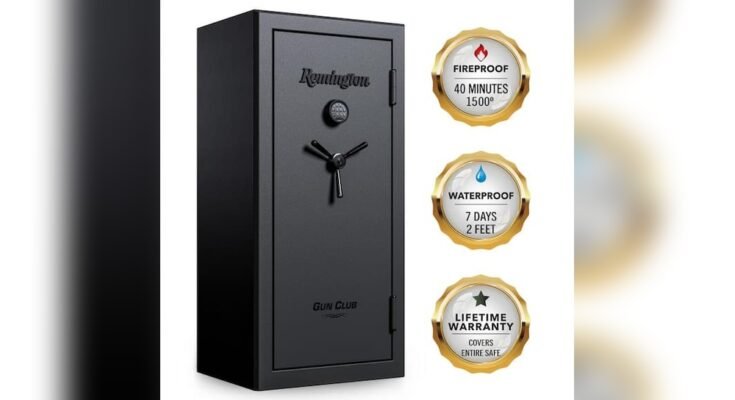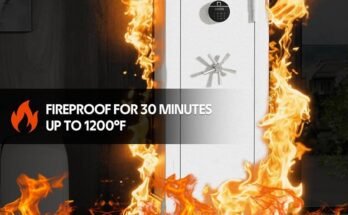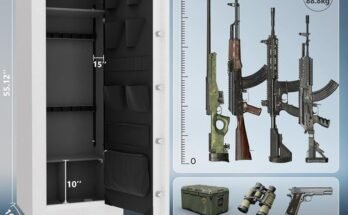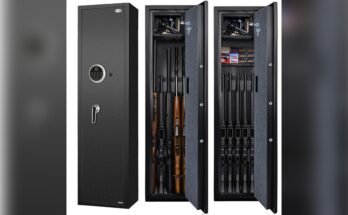When it comes to protecting your rifle, safety is more than just handling—it’s about the materials that keep it secure and fireproof. You want to make sure your firearm is stored in a way that can withstand extreme heat or accidental fires.
But what exactly makes a rifle safe fireproof? Understanding the right materials can give you peace of mind and protect your investment. You’ll discover which materials offer the best fire resistance and why they matter for your rifle’s safety. Keep reading to learn how to safeguard your rifle the smart way.

Fireproof Materials For Rifles
Fireproof materials protect rifles from extreme heat and fire damage. These materials keep the rifle safe and functional in harsh conditions. Choosing the right fireproof components increases durability and safety.
Heat-resistant Metals
Heat-resistant metals like stainless steel and titanium withstand high temperatures. They do not melt or deform easily under fire. These metals provide strength and stability to rifle parts. Their resistance helps maintain the rifle’s structure during heat exposure.
Ceramic Components
Ceramics resist heat and act as strong barriers against fire. They do not conduct heat quickly, protecting internal rifle parts. Ceramic coatings or inserts reduce damage from flames. These materials add an extra layer of fire protection.
Fire-resistant Polymers
Fire-resistant polymers do not burn or melt easily. They can handle heat without breaking down. These plastics cover grips, stocks, or other rifle sections. Using fire-resistant polymers improves safety and comfort under heat stress.

Design Features Enhancing Fire Safety
Design features play a key role in making a rifle safe and fireproof. These features help protect the rifle from heat damage and prevent accidental fires. Understanding these design elements helps users choose safer rifles. The focus lies on materials and structures that reduce heat impact and contain flames.
Thermal Barriers
Thermal barriers block heat from reaching critical parts of the rifle. They are made from materials that resist high temperatures. These barriers slow down heat transfer during a fire. This delay protects the rifle’s internal components. Common thermal barriers include ceramic coatings and fire-resistant foams. They add an extra layer of safety without adding much weight.
Heat Dissipation Systems
Heat dissipation systems help spread heat away quickly. These systems use metals like aluminum or copper that conduct heat well. Heat moves from hot areas to cooler parts, lowering the risk of damage. Some rifles have fins or vents to improve air flow. This air flow cools the rifle and prevents heat buildup. Efficient heat dissipation reduces the chance of ignition or melting.
Sealed Chambers
Sealed chambers prevent fire and smoke from entering sensitive parts. These chambers are airtight and often lined with fireproof materials. They protect the rifle’s firing mechanism and ammunition. Sealed chambers limit oxygen flow, which slows combustion. This design helps keep the rifle functional even in extreme heat. They also stop sparks from escaping and causing external fires.
Protective Coatings And Treatments
Protective coatings and treatments play a key role in making rifles fireproof. These materials shield the rifle from heat and flames. They prevent damage and keep the rifle safe in dangerous conditions.
Such coatings are designed to resist high temperatures. They form a barrier that slows down heat transfer. This helps protect the metal parts and internal mechanisms of the rifle.
Different types of coatings serve various purposes. Some reflect heat, while others absorb or repel flames. Choosing the right coating depends on the level of fire resistance needed.
Heat-resistant Paints
Heat-resistant paints can endure very high temperatures. They are often used on gun barrels and metal surfaces. These paints prevent the metal from getting too hot.
They also reduce the risk of the rifle’s finish cracking or peeling. Heat-resistant paints come in many colors and finishes. Applying these paints adds a layer of protection from fire and heat.
Ceramic Coatings
Ceramic coatings are very strong and heat resistant. They create a tough shell around the rifle parts. This shell blocks heat and flames from reaching the metal inside.
These coatings also resist scratches and corrosion. Ceramic coatings last longer than regular paints. They keep the rifle safe even in extreme heat conditions.
Anti-flammable Sprays
Anti-flammable sprays form a fire-resistant layer on the rifle. They work by slowing down or stopping flames. These sprays can be applied quickly and easily.
They often contain chemicals that expand when heated. This expansion creates a protective foam barrier. Anti-flammable sprays help protect rifles from sudden fire exposure.

Testing And Standards For Fireproof Rifles
Testing and standards ensure that fireproof rifles meet strict safety and quality rules. These tests check how well materials resist heat and flames. They also measure the rifle’s durability in tough conditions. Understanding these tests helps buyers know the level of protection offered.
Industry Safety Certifications
Fireproof rifles must have certifications from trusted safety groups. These certificates prove the rifle passed key fire resistance tests. Common certifications include UL (Underwriters Laboratories) and ASTM (American Society for Testing and Materials). Certifications show the rifle meets national and international safety rules.
Fire Exposure Testing
This test exposes the rifle to high temperatures for a set time. It checks if the rifle’s materials can stop fire damage. Some tests use open flames or heat chambers. The rifle must keep its shape and function after fire exposure. This proves the materials can protect the rifle in real fires.
Durability Assessments
Durability tests simulate rough use and long-term wear. They include dropping, vibration, and impact tests. These checks ensure the fireproof material stays strong under stress. Durability is key to keeping rifles safe during fires and accidents. Reliable materials prevent damage and maintain safety features.
Maintenance Tips For Fire Safety
Maintaining your rifle’s fire safety is essential for long-lasting protection. Proper care helps fire-resistant materials perform well. Simple steps keep your rifle safe from fire damage. These tips focus on inspection, cleaning, and storage.
Regular Inspection
Check your rifle often for any signs of damage. Look for cracks, rust, or wear on fireproof parts. Early detection helps avoid bigger problems. Inspect seals and hinges carefully to ensure tight closure. Replace damaged components quickly to keep fire resistance strong.
Cleaning Fire-resistant Parts
Use a soft brush or cloth to clean fireproof materials. Avoid harsh chemicals that can weaken fire-resistant coatings. Remove dust and debris gently to maintain protection. Clean metal parts with oil to stop rust. Keep all surfaces dry to prevent damage.
Storage Recommendations
Store your rifle in a cool, dry place away from heat. Use a fireproof safe or cabinet for added security. Keep the area free from flammable materials. Ensure good ventilation to reduce moisture build-up. Regularly check storage conditions to maintain fire safety.
Frequently Asked Questions
What Materials Ensure A Rifle Safe Is Fireproof?
Fireproof rifle safes use materials like steel, concrete, and gypsum. These materials resist high temperatures and prevent fire damage. Steel offers structural strength, while gypsum absorbs heat. Concrete adds extra insulation, keeping firearms safe during fires.
How Does Gypsum Protect A Rifle Safe From Fire?
Gypsum in rifle safes acts as a heat barrier. It absorbs and slows down heat transfer. This prevents internal temperatures from rising quickly, protecting firearms and ammunition inside. Gypsum is essential for meeting fire-resistance standards in safes.
Why Is Steel Important In Fireproof Rifle Safes?
Steel provides durability and heat resistance in rifle safes. It withstands high temperatures and physical attacks. Steel construction helps maintain the safe’s shape and integrity during a fire, ensuring firearms stay protected.
Can Concrete Enhance A Rifle Safe’s Fire Resistance?
Yes, concrete adds thermal insulation to rifle safes. It slows heat penetration and strengthens the safe’s walls. This extra layer helps maintain safe temperatures inside during prolonged fires, offering better protection for firearms.
Conclusion
Choosing the right materials keeps rifles safe from fire damage. Metals like steel and aluminum resist heat well. Fireproof coatings add extra protection. Heat-resistant foams and ceramics also help block flames. Safe storage means using these materials wisely. Protect your rifle by understanding what works best.
This knowledge ensures your firearm lasts longer and stays secure. Safety and care go hand in hand. Simple steps make a big difference. Keep your rifle safe and ready.



